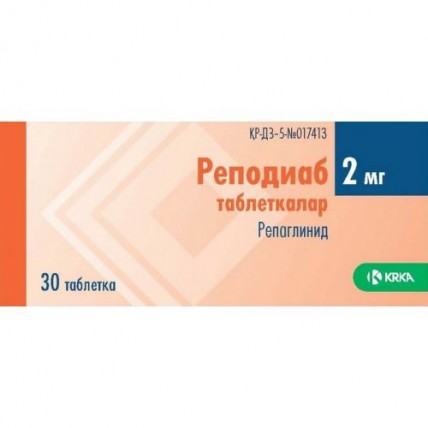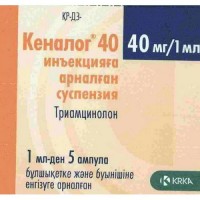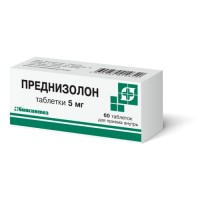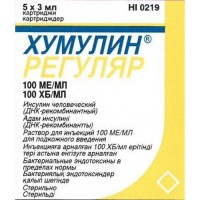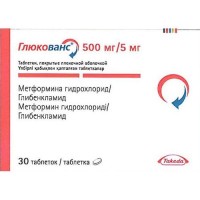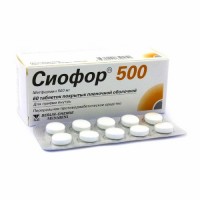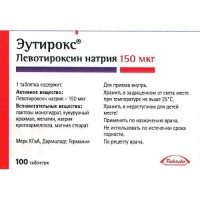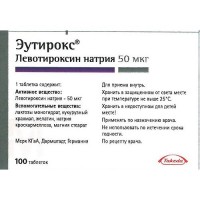Repodiab (Repaglinide) 2mg (30 tablets)
- $11.60
Repaglinide is a drug used in the treatment of diabetes mellitus type 2. It belongs to a class of antihyperglycemic agents known as meglitinides, along with nateglinide. Meglitinides work to reduce blood glucose levels by stimulating endogenous insulin production. The present recommended starting dose is dependent on hemoglobin A1c levels, with those below 8% (64 mmol/mol) urged to start with 0.5mg pre-prandially, and those above 8% to start with 1 to 2mg.
One tablet contains:
active substance - repaglinide 0.5 mg, 1 mg and 2 mg,
excipients: calcium hydrogen phosphate anhydrous, microcrystalline cellulose, sodium croscarmellose, meglumine, poloxamer, glycerin, povidone K 25, magnesium stearate, iron oxide yellow E 172 (for a dosage of 1 mg), iron oxide red E 172 (for a dosage of 2 mg).
- type 2 diabetes mellitus (non-insulin dependent) with ineffective diet therapy, weight loss and physical activity (as monotherapy or in combination with metformin)
For oral administration.
The drug is prescribed as an adjunct to diet therapy and physical activity in order to lower blood glucose levels. The use of the drug should be confined to meals.
Reodiab is taken before every main meal.
Doses are adjusted individually to achieve optimal glucose levels. In addition to routine patient monitoring of blood glucose and / or glucosuria, periodically the glucose level should be checked by a physician to determine the minimum effective dose for the patient. It is also necessary to monitor the level of glycosylated hemoglobin to assess the patient's overall response to treatment. It is recommended to periodically monitor blood glucose levels against the background of taking maximum doses to timely detect an insufficient decrease in blood glucose levels (i.e., diagnosis of primary drug resistance) or to detect a subsequent decrease in the effectiveness of the drug (i.e., secondary drug resistance)...
In patients with type 2 diabetes mellitus, usually successfully controlled by diet, with a transient deterioration in blood glucose control, a short course of Repodiab may be sufficient.
The drug is usually taken 15 minutes before a meal, but the tablets can be taken 30 minutes or just before a meal. The frequency of administration is 2, 3 or 4 times a day. If a meal is missed, or the patient is taking food additionally, the drug intake is also skipped or added accordingly.
Initial dose
The dose is set by the doctor, depending on the needs of the patient.
The recommended starting dose is 0.5 mg. The dose is increased at intervals of one to two weeks (while focusing on blood glucose levels as an indicator of response to therapy).
When switching from another hypoglycemic drug to repaglinide, the recommended starting dose of Repodiab is 1 mg.
Maintenance dose
The recommended maximum single dose is 4 mg before main meals.
The total maximum daily dose should not exceed 16 mg.
Patients taking other oral glucose-lowering drugs
Patients can be directly switched from therapy with other antihyperglycemic drugs to therapy with Repodiab. However, there are no exact dose ratios between the various oral hypoglycemic drugs and Repodiab. The recommended maximum starting dose for switching to Repodiab is 1 mg before main meals.
Repodiab can be used in combination with metformin if metformin monotherapy does not provide adequate glycemic control. In this case, the dose of metformin is left unchanged and repaglinide therapy is added. The initial dose of Repodiab in this case is 0.5 mg before the main meals; the dose change depends on the glucose response, as with Repodiab monotherapy.
When using Repodiab, the following adverse effects were noted, which are classified as follows by the frequency of development:
- often (³1 / 100 to <1/10)
- sometimes (³1 / 1000 to <1/100)
- rarely (³1 / 10000 to <1/1000)
- very rare (<1/10000)
- the frequency is unknown (cannot be established from the available data)
Often
- hypoglycemia
- abdominal pain, diarrhea
Very rarely
- allergies, generalized hypersensitivity reactions (eg, anaphylactic reactions), or immunological reactions such as vasculitis
- vomiting, constipation
- visual disturbances. It is known that changes in blood glucose levels are accompanied by temporary visual disturbances, especially at the beginning of treatment. Such violations were observed only in isolated cases at the beginning of therapy with repaglinide in clinical trials. None of them required cancellation of repaglinide
- dysfunction of the liver, increased activity of liver enzymes. In very rare cases, severe liver dysfunction has been reported. A causal relationship with repaglinide has not been established. There are isolated reports of an increase in the activity of liver enzymes during treatment with repaglinide. In most cases, the increase was mild and intermittent, and very few patients discontinued the drug due to elevated liver enzyme levels.
Frequency unknown
- hypoglycemic coma and loss of consciousness against the background of hypoglycemia. Hypoglycemic reactions have been observed when taking Repodiab, like other antihyperglycemic drugs. These reactions are usually poorly expressed and easily controlled by the intake of carbohydrates. In severe cases, third-party assistance and intravenous glucose may be required. The frequency of these reactions depends, as with any therapy for diabetes mellitus, on individual factors such as dietary habits, drug dosage, intensity of exercise and stress. Interaction with other medicinal products may increase the risk of hypoglycemia. During the period of post-marketing use of repaglinide, cases of hypoglycemia were observed in patients taking the drug in combination with metformin or thiazolidinedione derivatives.
- nausea. The frequency and severity of complaints from the digestive system, such as abdominal pain, diarrhea, nausea, vomiting and constipation, reported in clinical trials, did not differ from that with other stimulants of insulin secretion.
- skin reactions of hypersensitivity, which can be manifested by erythema, itching, rash and urticaria. There is no reason to suspect the presence of cross-hypersensitivity with sulfonylurea derivatives due to the difference in their chemical structure
- hypersensitivity to repaglinide and other components of the drug
- type I diabetes mellitus (insulin dependent), C-peptide negative
- diabetic ketoacidosis, diabetic precoma and coma
- severe dysfunction of the liver, kidneys
- simultaneous use of gemfibrozil
- pregnancy and lactation
- children and adolescents up to 18 years of age (data on safety and effectiveness are limited)
Certain drugs are known to interfere with the metabolism of repaglinide, so it is imperative that the physician takes into account possible interactions.
Laboratory data show that repaglinide is metabolized primarily by CYP2C8 as well as CYP3A4. Clinical data from healthy volunteers confirm that CYP2C8 is the most important enzyme involved in repaglinide metabolism, with CYP3A4 playing a less important role, but the relative contribution of CYP3A4 can be increased by inhibition of CYP2C8. Therefore, the metabolism, and therefore the clearance of repaglinide, can be altered by drugs that inhibit or induce enzymes. Particular care must be taken while taking CYP2C8 and 3A4 inhibitors with repaglinide.
The following substances can enhance and / or prolong the hypoglycemic effect of repaglinide: gemfibrozil, clarithromycin, itraconazole, ketoconazole, trimethoprim, cyclosporine, other antidiabetic drugs, monoamine oxidase (MAO) inhibitors, non-selective beta-blockers, anti-inflammatory steroids inhibitors , octreotide, alcohol, anabolic steroids.
Concomitant administration of gemfibrozil (600 mg twice a day), a CYP2C8 inhibitor and repaglinide (single dose 0.25 mg) increased the area under the curve (AUC) of repaglinide by 8.1 times, and the maximum plasma concentration (Cmax) by 2.4 times in healthy volunteers. The half-life of repaglinide increased from 1.3 hours to 3.7 hours, which probably led to an enhanced and longer-lasting effect of lowering blood glucose levels, and the concentration of repaglinide in plasma after 7 hours increased 28.6 times. The simultaneous administration of gemfibrozil and repaglinide is contraindicated.
Concomitant administration of trimethoprim (160 mg twice daily), a moderate inhibitor of CYP2C8, and repaglinide (single dose 0.25 mg) increased the area under the repaglinide curve, Cmax and t (1.6 times, 1.4 times and 1.2 times respectively) without a statistically significant effect on blood glucose levels. This effect was observed with a subtherapeutic dose of repaglinide. Since the safety profile of this combination has not been established at doses above 0.25 mg for repaglinide and 320 mg for trimethoprim, concomitant administration of trimethoprim with repaglinide should be avoided. In the case of concomitant use of these drugs, careful monitoring of blood glucose levels, as well as clinical monitoring, is necessary.
Rifampicin, a potent inducer of CYP3A4 and CYP2C8, acts as both an inducer and an inhibitor of repaglinide metabolism. A seven-day preliminary course of rifampicin (600 mg), followed by simultaneous administration of repaglinide (single dose of 4 mg) on the seventh day, resulted in a 50% decrease in AUC (effect of combined induction and inhibition). When repaglinide was taken 24 hours after the last dose of rifampicin, there was an 80% reduction in the AUC of repaglinide (induction effect). Simultaneous administration of rifampicin and repaglinide may lead to the need to adjust the dose of repaglinide, while regulation should be based on careful monitoring of glucose concentration from the beginning of rifampicin administration (acute inhibition), after dosing (combination of inhibition and induction), withdrawal (induction only) and during the period up to about two weeks after discontinuation of rifampicin, in case when the inductive effect of rifampicin is no longer present. It cannot be ruled out that other inducers, for example, diphenin, carbamazepine, phenobarbital, St. John's wort, cannot have a similar effect.
The effect of ketoconazole, a prototype of potent and competitive inhibitors of CYP3A4, on the pharmacokinetics of repaglinide has been studied in healthy individuals. The simultaneous administration of 200 mg of ketoconazole increased the AUC and Cmax of repaglinide by 1.2 times, while simultaneously changing the blood glucose concentration profiles by less than 8% while taking it (a single dose of 4 mg of repaglinide). Concomitant administration of 100 mg of itraconazole, a CYP3A4 inhibitor, increased the AUC of repaglinide by 1.4 times. There was no significant effect on glucose levels in healthy volunteers. While taking 250 mg of clarithromycin, which, due to the mechanism of action, is a potent inhibitor of CYP3A4 and repaglinide, slightly increased the AUC of repaglinide by 1.4 times and Cmax by 1.7 times, and also increased the average incremental AUC of insulin in serum by 1.5 times. and also the maximum concentration 1.6 times. The exact mechanism of this interaction is unclear.
In a study conducted on healthy volunteers, the simultaneous administration of repaglinide (single dose 0.25 mg) and cyclosporine (multiple dose 100 mg) increased the AUC and Cmax of repaglinide approximately 2.5 times and 1.8 times, respectively. Since an interaction has been established at doses above 0.25 mg for repaglinide, the simultaneous use of cyclosporine with repaglinide should be avoided. If it is necessary to use such a combination, it is necessary to carry out detailed clinical monitoring, as well as monitoring of glucose in the blood.
β-blockers can mask symptoms of hypoglycemia.
Simultaneous administration of cimetidine, nifedipine, estrogens, or simvastatin with repaglinide, which are substrates of CYP3A4, did not significantly change the pharmacokinetic parameters of repaglinide.
Repaglinide had no clinically significant effect on the pharmacokinetic properties of digoxin, theophylline, or warfarin at equilibrium. Therefore, there is no need to adjust the dose of these compounds while taking with repaglinide.
The following substances can reduce the hypoglycemic effect of repaglinide: oral contraceptives, rifampicin, barbiturates, carbamazepine, thiazides, corticosteroids, danazol, thyroid hormones, and sympathomimetics.
When these drugs are prescribed to a patient or discontinued in a patient receiving repaglinide, blood glucose levels must be closely monitored.
When prescribing repaglinide together with other drugs that are mainly excreted in bile, such as repaglinide, their potential interactions must be considered.
General information
Repodiab should be prescribed only in case of insufficient glycemic control and persisting symptoms of diabetes mellitus against the background of adherence to diet, weight loss and exercise regimen.
Repodiab, like other insulin secretion stimulants, can cause hypoglycemia.
The sugar-lowering effect of oral hypoglycemic agents decreases over time in many patients. This may be due to the progression of the severity of diabetes or to a decrease in drug sensitivity. This phenomenon is known as secondary drug resistance, which must be distinguished from primary drug resistance, in which the drug is ineffective in some patients as soon as it is first administered. Before diagnosing secondary drug resistance, you should try to change the dose of the drug and check the adequacy of diet and exercise regimen.
Repaglinide acts through specific binding sites with a short effect on β-cells. The use of Repodiab in the case of secondary drug resistance to stimulants of insulin secretion has not been studied in clinical trials.
Studies of combination therapy with other drugs that stimulate insulin secretion and acarbose have not been conducted.
There have been studies of combination therapy with neutral protamine insulin or thiazolidinediones. However, a benefit / risk ratio can be established when comparing with other combination therapy options.
Combination therapy with metformin is associated with an increased risk of hypoglycemia.
If a patient with stable values while taking an oral hypoglycemic agent is exposed to stressful factors, such as fever, trauma, infection, or surgery, glucose control may be lost. In such cases, it may be necessary to temporarily discontinue repaglinide and prescribe insulin.
Simultaneous application
It is necessary to use the drug with caution or to refuse its use in patients receiving drugs that affect the metabolism of repaglinide. If simultaneous use is necessary, close monitoring of the level of glucose in the blood and close clinical observation.
Special patient groups
Use with caution in kidney disease. Since diabetic patients with renal insufficiency have increased insulin sensitivity, in such patients the dose of the drug should be selected with caution.
Clinical studies have not been conducted in patients with impaired liver function. The administration of usual doses of Repodiab can lead to higher concentrations of repaglinide and its metabolites than in patients with normal liver function.
Clinical studies of the safety and efficacy of the drug have not been conducted in patients over 75 years old. Therefore, in this group of patients, drug therapy is not recommended.
In debilitated patients or in patients with reduced nutrition, the initial and maintenance doses should be minimal, and careful dose selection is required to prevent hypoglycemic reactions.
During the period of treatment, patients should refrain from drinking alcohol, since ethanol can enhance and prolong the hypoglycemic effect of repaglinide.
Features of the effect of the drug on the ability to drive a vehicle or potentially dangerous mechanisms
Patients are advised to be careful and avoid hypoglycemia while driving. This is especially important for those patients who have little or no hypoglycemic symptoms, or who often experience episodes of hypoglycemia. Patients need to be educated about what measures should be taken in such situations.
Symptoms: hypoglycemic state (weakness, headache, sweating, tremors, hunger, tachycardia, pallor).
Treatment: when symptoms of hypoglycemia appear, carbohydrate intake is required; more severe hypoglycemia with convulsions, loss of consciousness and the development of coma should be stopped by intravenous administration of glucose.
Store in a dark place at a temperature not exceeding 25 ° C.
Keep out of the reach of children!
Shelf life - 2 years
Do not use after the expiration date.
Structure
One tablet contains:
active substance - repaglinide 0.5 mg, 1 mg and 2 mg,
excipients: calcium hydrogen phosphate anhydrous, microcrystalline cellulose, sodium croscarmellose, meglumine, poloxamer, glycerin, povidone K 25, magnesium stearate, iron oxide yellow E 172 (for a dosage of 1 mg), iron oxide red E 172 (for a dosage of 2 mg).
Indications for use
- type 2 diabetes mellitus (non-insulin dependent) with ineffective diet therapy, weight loss and physical activity (as monotherapy or in combination with metformin)
Method of administration and dosage
For oral administration.
The drug is prescribed as an adjunct to diet therapy and physical activity in order to lower blood glucose levels. The use of the drug should be confined to meals.
Reodiab is taken before every main meal.
Doses are adjusted individually to achieve optimal glucose levels. In addition to routine patient monitoring of blood glucose and / or glucosuria, periodically the glucose level should be checked by a physician to determine the minimum effective dose for the patient. It is also necessary to monitor the level of glycosylated hemoglobin to assess the patient's overall response to treatment. It is recommended to periodically monitor blood glucose levels against the background of taking maximum doses to timely detect an insufficient decrease in blood glucose levels (i.e., diagnosis of primary drug resistance) or to detect a subsequent decrease in the effectiveness of the drug (i.e., secondary drug resistance)...
In patients with type 2 diabetes mellitus, usually successfully controlled by diet, with a transient deterioration in blood glucose control, a short course of Repodiab may be sufficient.
The drug is usually taken 15 minutes before a meal, but the tablets can be taken 30 minutes or just before a meal. The frequency of administration is 2, 3 or 4 times a day. If a meal is missed, or the patient is taking food additionally, the drug intake is also skipped or added accordingly.
Initial dose
The dose is set by the doctor, depending on the needs of the patient.
The recommended starting dose is 0.5 mg. The dose is increased at intervals of one to two weeks (while focusing on blood glucose levels as an indicator of response to therapy).
When switching from another hypoglycemic drug to repaglinide, the recommended starting dose of Repodiab is 1 mg.
Maintenance dose
The recommended maximum single dose is 4 mg before main meals.
The total maximum daily dose should not exceed 16 mg.
Patients taking other oral glucose-lowering drugs
Patients can be directly switched from therapy with other antihyperglycemic drugs to therapy with Repodiab. However, there are no exact dose ratios between the various oral hypoglycemic drugs and Repodiab. The recommended maximum starting dose for switching to Repodiab is 1 mg before main meals.
Repodiab can be used in combination with metformin if metformin monotherapy does not provide adequate glycemic control. In this case, the dose of metformin is left unchanged and repaglinide therapy is added. The initial dose of Repodiab in this case is 0.5 mg before the main meals; the dose change depends on the glucose response, as with Repodiab monotherapy.
Side effects
When using Repodiab, the following adverse effects were noted, which are classified as follows by the frequency of development:
- often (³1 / 100 to <1/10)
- sometimes (³1 / 1000 to <1/100)
- rarely (³1 / 10000 to <1/1000)
- very rare (<1/10000)
- the frequency is unknown (cannot be established from the available data)
Often
- hypoglycemia
- abdominal pain, diarrhea
Very rarely
- allergies, generalized hypersensitivity reactions (eg, anaphylactic reactions), or immunological reactions such as vasculitis
- vomiting, constipation
- visual disturbances. It is known that changes in blood glucose levels are accompanied by temporary visual disturbances, especially at the beginning of treatment. Such violations were observed only in isolated cases at the beginning of therapy with repaglinide in clinical trials. None of them required cancellation of repaglinide
- dysfunction of the liver, increased activity of liver enzymes. In very rare cases, severe liver dysfunction has been reported. A causal relationship with repaglinide has not been established. There are isolated reports of an increase in the activity of liver enzymes during treatment with repaglinide. In most cases, the increase was mild and intermittent, and very few patients discontinued the drug due to elevated liver enzyme levels.
Frequency unknown
- hypoglycemic coma and loss of consciousness against the background of hypoglycemia. Hypoglycemic reactions have been observed when taking Repodiab, like other antihyperglycemic drugs. These reactions are usually poorly expressed and easily controlled by the intake of carbohydrates. In severe cases, third-party assistance and intravenous glucose may be required. The frequency of these reactions depends, as with any therapy for diabetes mellitus, on individual factors such as dietary habits, drug dosage, intensity of exercise and stress. Interaction with other medicinal products may increase the risk of hypoglycemia. During the period of post-marketing use of repaglinide, cases of hypoglycemia were observed in patients taking the drug in combination with metformin or thiazolidinedione derivatives.
- nausea. The frequency and severity of complaints from the digestive system, such as abdominal pain, diarrhea, nausea, vomiting and constipation, reported in clinical trials, did not differ from that with other stimulants of insulin secretion.
- skin reactions of hypersensitivity, which can be manifested by erythema, itching, rash and urticaria. There is no reason to suspect the presence of cross-hypersensitivity with sulfonylurea derivatives due to the difference in their chemical structure
Contraindications
- hypersensitivity to repaglinide and other components of the drug
- type I diabetes mellitus (insulin dependent), C-peptide negative
- diabetic ketoacidosis, diabetic precoma and coma
- severe dysfunction of the liver, kidneys
- simultaneous use of gemfibrozil
- pregnancy and lactation
- children and adolescents up to 18 years of age (data on safety and effectiveness are limited)
Drug interactions
Certain drugs are known to interfere with the metabolism of repaglinide, so it is imperative that the physician takes into account possible interactions.
Laboratory data show that repaglinide is metabolized primarily by CYP2C8 as well as CYP3A4. Clinical data from healthy volunteers confirm that CYP2C8 is the most important enzyme involved in repaglinide metabolism, with CYP3A4 playing a less important role, but the relative contribution of CYP3A4 can be increased by inhibition of CYP2C8. Therefore, the metabolism, and therefore the clearance of repaglinide, can be altered by drugs that inhibit or induce enzymes. Particular care must be taken while taking CYP2C8 and 3A4 inhibitors with repaglinide.
The following substances can enhance and / or prolong the hypoglycemic effect of repaglinide: gemfibrozil, clarithromycin, itraconazole, ketoconazole, trimethoprim, cyclosporine, other antidiabetic drugs, monoamine oxidase (MAO) inhibitors, non-selective beta-blockers, anti-inflammatory steroids inhibitors , octreotide, alcohol, anabolic steroids.
Concomitant administration of gemfibrozil (600 mg twice a day), a CYP2C8 inhibitor and repaglinide (single dose 0.25 mg) increased the area under the curve (AUC) of repaglinide by 8.1 times, and the maximum plasma concentration (Cmax) by 2.4 times in healthy volunteers. The half-life of repaglinide increased from 1.3 hours to 3.7 hours, which probably led to an enhanced and longer-lasting effect of lowering blood glucose levels, and the concentration of repaglinide in plasma after 7 hours increased 28.6 times. The simultaneous administration of gemfibrozil and repaglinide is contraindicated.
Concomitant administration of trimethoprim (160 mg twice daily), a moderate inhibitor of CYP2C8, and repaglinide (single dose 0.25 mg) increased the area under the repaglinide curve, Cmax and t (1.6 times, 1.4 times and 1.2 times respectively) without a statistically significant effect on blood glucose levels. This effect was observed with a subtherapeutic dose of repaglinide. Since the safety profile of this combination has not been established at doses above 0.25 mg for repaglinide and 320 mg for trimethoprim, concomitant administration of trimethoprim with repaglinide should be avoided. In the case of concomitant use of these drugs, careful monitoring of blood glucose levels, as well as clinical monitoring, is necessary.
Rifampicin, a potent inducer of CYP3A4 and CYP2C8, acts as both an inducer and an inhibitor of repaglinide metabolism. A seven-day preliminary course of rifampicin (600 mg), followed by simultaneous administration of repaglinide (single dose of 4 mg) on the seventh day, resulted in a 50% decrease in AUC (effect of combined induction and inhibition). When repaglinide was taken 24 hours after the last dose of rifampicin, there was an 80% reduction in the AUC of repaglinide (induction effect). Simultaneous administration of rifampicin and repaglinide may lead to the need to adjust the dose of repaglinide, while regulation should be based on careful monitoring of glucose concentration from the beginning of rifampicin administration (acute inhibition), after dosing (combination of inhibition and induction), withdrawal (induction only) and during the period up to about two weeks after discontinuation of rifampicin, in case when the inductive effect of rifampicin is no longer present. It cannot be ruled out that other inducers, for example, diphenin, carbamazepine, phenobarbital, St. John's wort, cannot have a similar effect.
The effect of ketoconazole, a prototype of potent and competitive inhibitors of CYP3A4, on the pharmacokinetics of repaglinide has been studied in healthy individuals. The simultaneous administration of 200 mg of ketoconazole increased the AUC and Cmax of repaglinide by 1.2 times, while simultaneously changing the blood glucose concentration profiles by less than 8% while taking it (a single dose of 4 mg of repaglinide). Concomitant administration of 100 mg of itraconazole, a CYP3A4 inhibitor, increased the AUC of repaglinide by 1.4 times. There was no significant effect on glucose levels in healthy volunteers. While taking 250 mg of clarithromycin, which, due to the mechanism of action, is a potent inhibitor of CYP3A4 and repaglinide, slightly increased the AUC of repaglinide by 1.4 times and Cmax by 1.7 times, and also increased the average incremental AUC of insulin in serum by 1.5 times. and also the maximum concentration 1.6 times. The exact mechanism of this interaction is unclear.
In a study conducted on healthy volunteers, the simultaneous administration of repaglinide (single dose 0.25 mg) and cyclosporine (multiple dose 100 mg) increased the AUC and Cmax of repaglinide approximately 2.5 times and 1.8 times, respectively. Since an interaction has been established at doses above 0.25 mg for repaglinide, the simultaneous use of cyclosporine with repaglinide should be avoided. If it is necessary to use such a combination, it is necessary to carry out detailed clinical monitoring, as well as monitoring of glucose in the blood.
β-blockers can mask symptoms of hypoglycemia.
Simultaneous administration of cimetidine, nifedipine, estrogens, or simvastatin with repaglinide, which are substrates of CYP3A4, did not significantly change the pharmacokinetic parameters of repaglinide.
Repaglinide had no clinically significant effect on the pharmacokinetic properties of digoxin, theophylline, or warfarin at equilibrium. Therefore, there is no need to adjust the dose of these compounds while taking with repaglinide.
The following substances can reduce the hypoglycemic effect of repaglinide: oral contraceptives, rifampicin, barbiturates, carbamazepine, thiazides, corticosteroids, danazol, thyroid hormones, and sympathomimetics.
When these drugs are prescribed to a patient or discontinued in a patient receiving repaglinide, blood glucose levels must be closely monitored.
When prescribing repaglinide together with other drugs that are mainly excreted in bile, such as repaglinide, their potential interactions must be considered.
Special instructions
General information
Repodiab should be prescribed only in case of insufficient glycemic control and persisting symptoms of diabetes mellitus against the background of adherence to diet, weight loss and exercise regimen.
Repodiab, like other insulin secretion stimulants, can cause hypoglycemia.
The sugar-lowering effect of oral hypoglycemic agents decreases over time in many patients. This may be due to the progression of the severity of diabetes or to a decrease in drug sensitivity. This phenomenon is known as secondary drug resistance, which must be distinguished from primary drug resistance, in which the drug is ineffective in some patients as soon as it is first administered. Before diagnosing secondary drug resistance, you should try to change the dose of the drug and check the adequacy of diet and exercise regimen.
Repaglinide acts through specific binding sites with a short effect on β-cells. The use of Repodiab in the case of secondary drug resistance to stimulants of insulin secretion has not been studied in clinical trials.
Studies of combination therapy with other drugs that stimulate insulin secretion and acarbose have not been conducted.
There have been studies of combination therapy with neutral protamine insulin or thiazolidinediones. However, a benefit / risk ratio can be established when comparing with other combination therapy options.
Combination therapy with metformin is associated with an increased risk of hypoglycemia.
If a patient with stable values while taking an oral hypoglycemic agent is exposed to stressful factors, such as fever, trauma, infection, or surgery, glucose control may be lost. In such cases, it may be necessary to temporarily discontinue repaglinide and prescribe insulin.
Simultaneous application
It is necessary to use the drug with caution or to refuse its use in patients receiving drugs that affect the metabolism of repaglinide. If simultaneous use is necessary, close monitoring of the level of glucose in the blood and close clinical observation.
Special patient groups
Use with caution in kidney disease. Since diabetic patients with renal insufficiency have increased insulin sensitivity, in such patients the dose of the drug should be selected with caution.
Clinical studies have not been conducted in patients with impaired liver function. The administration of usual doses of Repodiab can lead to higher concentrations of repaglinide and its metabolites than in patients with normal liver function.
Clinical studies of the safety and efficacy of the drug have not been conducted in patients over 75 years old. Therefore, in this group of patients, drug therapy is not recommended.
In debilitated patients or in patients with reduced nutrition, the initial and maintenance doses should be minimal, and careful dose selection is required to prevent hypoglycemic reactions.
During the period of treatment, patients should refrain from drinking alcohol, since ethanol can enhance and prolong the hypoglycemic effect of repaglinide.
Features of the effect of the drug on the ability to drive a vehicle or potentially dangerous mechanisms
Patients are advised to be careful and avoid hypoglycemia while driving. This is especially important for those patients who have little or no hypoglycemic symptoms, or who often experience episodes of hypoglycemia. Patients need to be educated about what measures should be taken in such situations.
Overdose
Symptoms: hypoglycemic state (weakness, headache, sweating, tremors, hunger, tachycardia, pallor).
Treatment: when symptoms of hypoglycemia appear, carbohydrate intake is required; more severe hypoglycemia with convulsions, loss of consciousness and the development of coma should be stopped by intravenous administration of glucose.
Storage conditions
Store in a dark place at a temperature not exceeding 25 ° C.
Keep out of the reach of children!
Shelf life - 2 years
Do not use after the expiration date.
